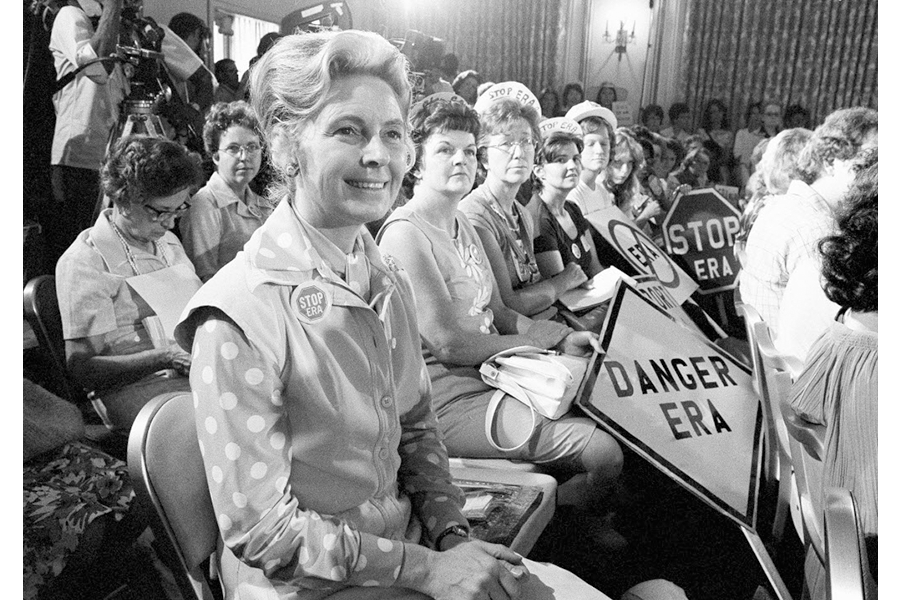Phyllis Schlafly: What legacy does she leave?
Loading...
Phyllis Schlafly, a conservative activist credited with the defeat of the Equal Rights Amendment (ERA), died at home on Monday. She was 92.
Mrs. Schlafly, who has been called the "first lady of the conservative movement," organized around numerous right-wing causes. Her self-published book "A Choice Not an Echo," which sold over 3 million copies, and her support of right-wing Arizona Sen. Barry Goldwater in his campaign for president in 1964 "planted the seeds of a conservative revival that would flower with the rise of Ronald Reagan," wrote Douglas Martin for The New York Times.
In March, Schlafly endorsed Donald J. Trump for president, despite disagreement among leaders in her organization, the Eagle Forum.
The self-described housewife had tremendous influence, noted by those across the political spectrum.
"Let it be said of Phyllis Schlafly that every idea she had was scatter-brained, dangerous, and hateful. The more influential she became, the worse off America became," Alan Wolfe wrote for The New Republic in 2005.
But he expounds on her impact:
If political influence consists in transforming this huge and cantankerous country in one’s preferred direction, Schlafly has to be regarded as one of the two or three most important Americans of the last half of the twentieth century. Tireless, committed, strategically brilliant, undeterred: she grew up in the Old Right environment of xenophobic isolationism and helped to transform it into a New Right politics of anti-communism. Had she never been born, the Constitution would now include an Equal Rights Amendment. Without ever serving in the House of Representatives – she ran twice, losing both times – she played an instrumental role in driving moderates out of the Republican Party and replacing them with the hard-right politicians who currently dominate Congress."
Although Schlafly fought against restrictions on nuclear weapons in an anti-Communism crusade, supported conservative politicians' campaigns, and ran for office herself, it was Schlafly's opposition to the ERA that made her a household name.
"Would the ERA have passed without Phyllis? That's the $64,000 question," Karen DeCrow, president of the National Organization for Women (NOW) in the mid-1970s who debated Schlafly numerous times, told the Los Angeles Times in 2005. "Bing-bing-bing, the states were ratifying it before she got involved. If she hadn't, then bing-bing-bing, we might have had three more states."
The ERA had passed Congress and was already ratified by 30 states when Schlafly first turned her attention to opposing it with a November 1972 newsletter headlined ''The Right To Be A Woman.''
Ultimately the ERA was ratified by just 35 states, three short of what was needed. By 1982, the ERA was defeated.
Schlafly's argument against the ERA was that it would signal the end of the traditional American family and remove the protections women enjoyed. She said the ERA "would open the door to same-sex marriage, abortion, the military draft for women, co-ed bathrooms and the end of labor laws that barred women from dangerous workplaces," writes Patricia Sullivan in The Washington Post.
In Schlafly's fight against the ERA, she founded the organization Stop ERA, which later became the Eagle Forum, which she led until her death.
Besides the ERA and communism, Schlafly also rallied against abortion and gay marriage.
While describing herself as a housewife, Schlafly had an extensive educational background. She earned a bachelor of arts degree from Washington University, a masters in political science from Radcliffe College, and a law degree from Washington University.
Between the masters and the law degree Schlafly married John Fred Schlafly Jr., a 39-year-old lawyer and politically engaged conservative. Interestingly, the wedding vows did not include the promise to obey, according to The New York Times.
Schlafly had six children, but she was back to traveling, writing, speaking, and campaigning just 18 months after the birth of her first child.
"She’s an extremely liberated woman," Ms. DeCrow said in an interview with Carol Felsenthal for her book “The Sweetheart of the Silent Majority: The Biography of Phyllis Schlafly” (1981), according to The New York Times. "She sets out to do something and she does it. To me, that’s liberation."
Still, Schlafly told The Christian Science Monitor in 1982 that her education and her law degree did not mean she was career-minded.
"I would rather be the wife of a lawyer than a lawyer," she said. "It's a nicer life. I enjoy being a wife, being the wife of a lawyer who will protect and defend and support his family."






